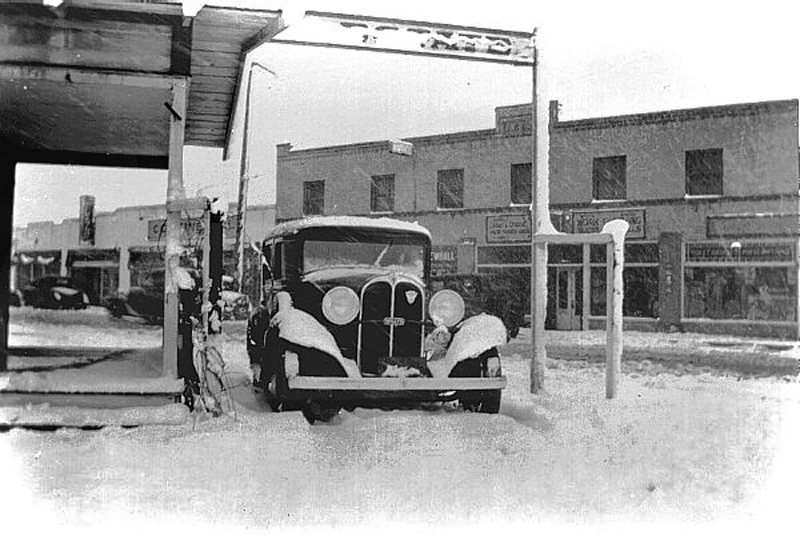|
|
Newhall, California

A proud car owner shows off his brand-new Willy's St. Clair in this photograph of a major stowstorm during the winter of 1931-32. The photo was taken from the intersection of Market Street and Spruce (later called San Fernando Road, then Main Street), looking southwest, toward the Swall Hotel across the street. The hotel was built in 1914 by entrepreneurial Newhall merchant Albert C. Swall. It housed a meat market/grocery store, hardware store and the Newhall Pharmacy, seen at extreme right. The brick hotel building was heavily damaged in the so-called Sylmar earthquake of Feb. 9, 1971. It was subsequently rebuilt and finished in Spanish-style stucco.
According to property owner Susan Davy (pers. comm. 1-26-2017), daughter of Newhall pharmacist Ralph Williams, the pharmacy building was completely torn down after the earthquake, the soil was compacted, and the structure was "rebuilt from scratch." "The months prior — about 1 year — to the earthquake, my husband and I spent remodeling the pharmacy building and all the store fronts beginning with 24263-65-67-69-71-73-75 San Fernando Road." "The night before the earthquake, we took some of the subcontractors out to Tip's to celebrate the finish of the pharmacy remodeling. You can imagine how everyone felt the morning of February 9, 1971." Winter 1931-32
By local standards, the winter of 1931-32 was especially harsh in the Newhall-Saugus area as the Los Angeles basin experienced its first significant snowfall in recorded history. By the time the first major storm of the season ended Dec. 14, 1931, Newhall was blanketed in nine inches of snow, and Saugus reported 10 inches[1]. Driving was dangerous if not impossible on the Ridge Route and on the Mint Canyon Route (Sierra Highway), which also saw 10 inches[2]. Ruth Watson and Clara Sanborn set out from Covina to see the snow but couldn't get beyond San Fernando. "Then they went to the veterans' hospital and saw two inches of snow there"[3]. Snow on the roof of the San Fernando Mission was a rare sight[4]. Mr. and Mrs. John J. Bottema of Arcadia had better luck on the roads. They brought their niece and a playmate to romp in the powder at their cabin near Newhall. "Great crowds enjoyed the snow, which fell to a depth of a foot, and the youngsters thoroughly entered into the spirit of play that was evident everywhere, the decision to return home being met with loud objections"[5]. The December storm also brought three inches of snow to eastern Ventura County. "Piru reported the heaviest fall with traffic in some instances tied up because of poor visibility and slippery pavements." Even Fillmore and Bardsdale experienced a two-hour snowfall.[6] The storms returned in January with a vengeance. On Jan. 15, 1932, Hollywood was covered in snow for the first time since the U.S. Weather Bureau (National Weather Service) started keeping track. Old-timers remembered snow falling in downtown Los Angeles around 1880, but not like this. It snowed at the beach at Santa Monica, in the mountains above Santa Barbara, and for the first time in memory at Santa Paula[7]. On January 29, a commercial aircraft carrying a pilot and seven passengers went down in the mountains between Lebec and Fort Tejon when visibility suddently dropped to zero. There were no survivors. It took searchers a week to locate the crash site. There was an eyewitness, but he couldn't get word through due to the storm. During the search for the downed plane, the U.S. Weather Bureau established a weather station at Sandberg on the Ridge Route to monitor the storm. It's still in use. On the upside, "snow men arose like magic on a thousand lawns" — and long-idle sleds, "brought out from the East ... were given their first West Coast workout by enthusiastic children"[8]. Then again, the coyote population in the San Fernando Valley "was disturbed greatly by the storm, and police shot several of the animals as they came out into the foothill areas"[9]. Seven students at Pasadena Junior College were arrested when a snowball fight turned into a riot. Police had to use nightsticks, water cannons and "tear bombs" to quell it[10]. A bystander was hospitalized after being struck in the eye a with snowball that had a rock inside it. The next severe storm wouldn't hit for another 17 years (Jan. 10-11, 1949), then another 13 years after that (Jan. 21, 1962). — Research by Tricia Lemon Putnam
1. Los Angeles Times, "General Rain and Snow Soaks Southland Area," Dec. 15, 1931. 2. ibid. 3. Covina (Calif.) Argus, Brief, Dec. 17, 1931. 4. Van Nuys News, "Snow Covers Valley Hills, Rain Heavy," Dec. 14, 1931. 5. Arcadia (Calif.) Tribune, "Heavy Snow Enjoyed by Newhall Cabin Owners," Dec. 18, 1931. 6. Los Angeles Times, Dec. 15, 1931, op.cit. 7. Los Angeles Times, "Los Angeles Snow-Clad First Time on Record," Jan. 16, 1932. 8. ibid. 9. ibid. 10. Los Angeles Times, "Storm Brings Student Riot," Jan. 16, 1932.
AP2822: 72 dpi jpeg from copy print |
The site owner makes no assertions as to ownership of any original copyrights to digitized images. However, these images are intended for Personal or Research use only. Any other kind of use, including but not limited to commercial or scholarly publication in any medium or format, public exhibition, or use online or in a web site, may be subject to additional restrictions including but not limited to the copyrights held by parties other than the site owner. USERS ARE SOLELY RESPONSIBLE for determining the existence of such rights and for obtaining any permissions and/or paying associated fees necessary for the proposed use.





